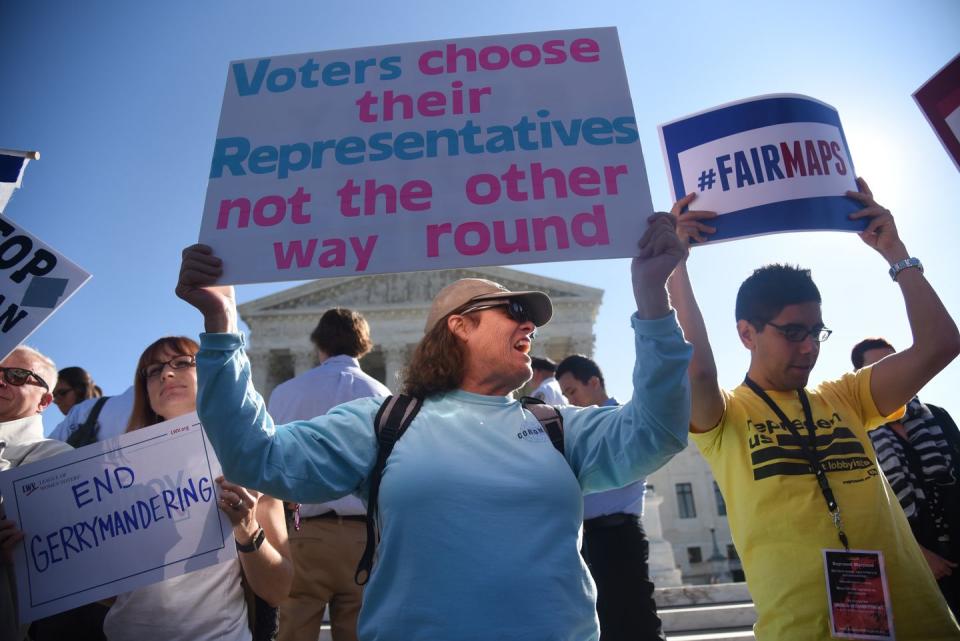That Horrific Anti-Abortion Law? It’s Brought to You by Voter Suppression

"Hearst Magazines and Yahoo may earn commission or revenue on some items through these links."
It’s election season and once again, abortion is on the ballot. Every pundit and politician is wondering if the American electorate’s desire to protect abortion rights will turn out voters in droves, deliver big wins for Democrats, and roll back terrifying anti-choice policies.
During the midterms, statewide ballot initiatives protecting abortion access swept the nation in a resounding rejection of the Supreme Court’s hostility to reproductive rights. Many were surprised that abortion won handily in places like Kansas, even as legislators there had been working overtime to restrict the procedure for decades. As a longtime reproductive justice journalist (Regina) and an organizer on behalf of people who have abortions (Renee), when people ask us, “How is this possible?” we usually have two answers: first, abortion is more popular than your favorite politician, and second, this is what happens when the issue is put directly to the will of the people.
As we cover on our new podcast from the Meteor, The A Files: A Secret History of Abortion, one of the biggest lies we’ve been told about abortion is that it’s a divisive issue—no, the most divisive political issue of our time. The truth is that abortion is more popular today than it has been in decades and support for the procedure has generally been quite high. In reality, only 14 percent of voters in states with the most restrictive laws say abortion should be illegal in all cases (yes, really, only 14 percent). But because of gerrymandering, it doesn’t matter what the majority of voters want.
So, what exactly is gerrymandering? It’s a tool lawmakers use to draw voting districts in a way that skews things in their favor come Election Day.
Here’s how it works: Every 10 years, states redraw the maps of their congressional and state legislative districts to reflect updated census data, and Republicans are simply a lot better at rigging this process to give themselves an edge than Democrats are. They did it methodically after the 2010 elections as part of the racist backlash to the election win of President Barack Obama. And they’re doing it now, following the 2020 redistricting process. “Let’s not forget we’re in a country where the enslavement of human beings used to be legal,” LaTosha Brown, cofounder of the voter engagement group Black Voters Matter, explained to us on our podcast. “There’s always been this vehicle around using the law and policy to be able to create barriers to make it very difficult for people to vote.”

One analysis found that for most of the last decade, Republicans gave themselves a 17-seat net advantage in the House of Representatives and similar gains in state legislatures across the country. The GOP does this by “cracking” or “packing” a district, which dilutes the strength of one particular group of voters in favor of another. When “cracking” a district, lawmakers break up districts with, for example, a lot of voters of color, by moving some of those voters to a new district with more conservatives so their vote has less power. While “packing” a district is where legislators put one type of voter into one district so they get only one representative at the state or federal level instead of the several they would be entitled to with a fairer map. Unsurprisingly, these lines are drawn based on where voters of color and those most likely to support abortion access live. The end result? Anti-choice politicians are locked into safe seats and have alarming, disproportionate sway to enact draconian laws curbing abortion access.
Historically, voting rights and abortion access are intimately connected—but proponents of each issue haven’t always seen it that way. Take the case of the Mississippi election in 2011, which we detail on our podcast: A personhood amendment seeking to end abortion was on the ballot at the same time as an initiative requiring voters to present identification at the ballot box, an effort to suppress the votes of Black and brown folks as well as young and low-income people. Despite efforts from local Black- and brown-led reproductive justice groups to organize against both initiatives as threats to democracy, large reproductive rights organizations only focused on stopping the abortion ban, not the voter restriction that would have similar lasting impacts. We believe that if reproductive rights organizations heeded the advice of local grassroots groups and broadened their focus, voters could have been engaged to protect access to the ballot and the clinic for years to come. As pro-choice activists celebrated the failure of the personhood amendment, the loss of voters’ rights was a huge blow to the people of Mississippi who were already disenfranchised.
Since then, the connection between anti-abortion efforts and voter disenfranchisement has only become clearer and stronger. Remember Kansas’s major victory in keeping abortion legal in the state? That win was possible because the issue went straight to the voters and not through their state legislators who are kept in power by gerrymandering. The state’s redistricting practices have diluted the voting power of Kansans of color, who tend to consistently support abortion rights, making it difficult for them to change who holds state office. Even as voters made it clear they wanted abortion to remain readily available, the Republican-controlled state legislature keeps pressing forward with dangerous anti-abortion measures, even overriding the Democratic governor’s veto of these bills, including one that requires providers to give patients medically inaccurate information about abortion pill reversal—a move tantamount to government-sanctioned medical experimentation.
Similarly, last fall Ohioans voted in support of protecting abortion in the state constitution, ensuring it would remain legal, in defiance of conservative legislators there who have been enacting anti-abortion restrictions for years. Right now, those same legislators are looking for ways to undo the will of the people—and it’s possible that the people have little to no recourse. The Ohio state Supreme Court recently allowed the state to keep its extremely partisan gerrymandered map through the 2024 elections. And in Ohio, like many other states, the Republican-led, gerrymandered legislature is also responsible for picking the state Supreme Court justices who will make final decisions on how state laws can be interpreted and applied. So much for checks and balances.
If we’re being honest, no one election will fix what’s already broken. It’s painful but true in a heavily gerrymandered voting system. That doesn’t mean we stop working to curtail voter suppression efforts. We have to continue showing up every election, particularly for off-year and local elections, where these changes to our voting systems are often on the ballot. And we must demand that our elected officials push for systemic change to ensure everyone who is eligible to vote can. That means working to expand voting rights, joining with Black Voters Matter or other community-based efforts to share resources and information, and taking action to restore the voting rights of formerly incarcerated people or other people who are disenfranchised because of the removal of ballot drop boxes or other suppression tactics. And of course, demanding expanded enfranchisement policies, such as automatic voter registration.
If we do not take seriously the connections between disenfranchisement and voter suppression tactics targeted at Black and brown people, abortion rights will never be guaranteed, no matter where you live or who you vote for. Abortion rights cannot exist without voting rights. When we isolate these issues from one another, we all lose.
You Might Also Like

